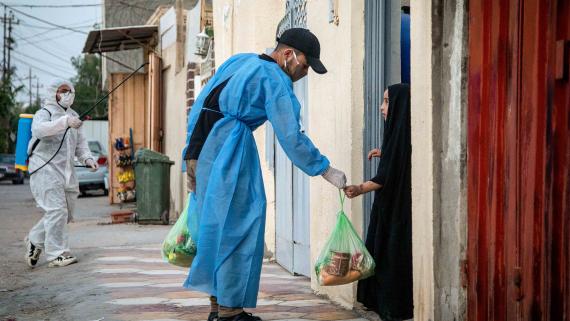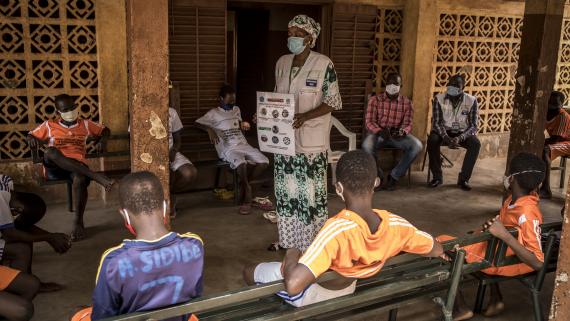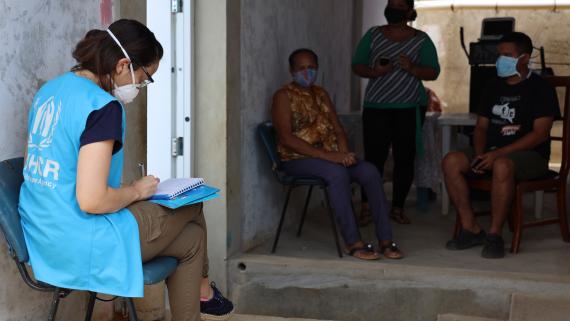Amran, Yemen
A community health worker in Amran visits a family to conduct a physically distant information session on how they can protect themselves from COVID-19. She provides medical information and refers them to healthcare services. Every day she navigates rough roads, cliffs and faces insecurity to visit vulnerable families who often are cut off from vital medical services because of ongoing conflict. UNICEF/Gabraz
Principled and effective aid and assistance place communities at the centre, ensuring that they drive humanitarian action. Accountability to Affected People (AAP) is the active commitment of humanitarians to ensure communities themselves have the power and influence to determine and act on their own priorities for preparedness, response and recovery.
AAP is grounded in the rights, dignity, capacity and safety of people and is built on three actions:
- Systematically sharing timely, relevant and actionable information with communities.
- Supporting the meaningful participation and leadership of affected people, including those of different sex, age, disability status and other diversities, in decision-making.
- Ensuring community feedback systems are in place, enabling them to assess and comment on the performance of humanitarian action, including on sensitive matters such as SEA, fraud, corruption, racism and discrimination.
In public health emergencies, community engagement is combined with risk communication specifically focused on the outbreak. COVID-19 has become a crisis of information. Combating misinformation and providing consistent and honest engagement are paramount for maintaining trust and public solidarity and promoting local action. Better understanding is needed in areas such as epidemiological trends, socioeconomic impacts or food security projections in humanitarian settings. Tackling these information issues will require the broadest range of actors working together.
Iraq: adapting assessment modalities during the pandemic

COVID-19 changed the operating environment in Iraq. Movement restrictions complicated access to communities, public offices closed and physical distancing disrupted face-to-face interaction with affected people. Finding new ways of interacting with affected populations and understanding their needs became imperative to ensure an evidence-based humanitarian response.
Partners made early strides to collect and analyse data. By mid-March, most monitoring and assessments switched to remote modalities, e.g. phone calls, or moved from household surveys to key informant interviews. As a result, data continued to be generated in areas such as remote protection monitoring to understand the impact of COVID-19 on protection risks among conflict-affected communities. Products that were generated through continued data collection included a monthly dashboard of COVID-19 concerns raised in calls to the the Iraq Information Center, a rapid survey on the impact of COVID-19, daily health statistics on COVID-19, the Iraq Weekly Food Security Monitor, and a mapping of camps’ capacities to deal with COVID-19 outbreaks. The data enabled humanitarian partners to adapt the response to COVID-19. Building on these practices, humanitarian partners successfully carried out multi-sectoral assessments to understand the severity of needs and availability of services and inform the 2021 HPC.
UNDP/Abdullah Dhiaa Al-deenA difficult lesson learned in disease outbreaks and humanitarian emergencies is that inadequate communication and engagement with communities in the planning and design of emergency response measures fuel fear and mistrust. Failure to meaningfully and strategically engage people, inclusive of gender, age, disability and other diversities, across all pillars of emergency preparedness and response can lead to ineffective interventions. It can even cause harm.
COVID-19 is a multi-centred pandemic: an outbreak of countless local epidemics, each one slightly different and requiring great focus on locally driven and multi-sectoral strategies. Just as the pandemic’s impact has moved beyond public health, so have coordination efforts. Coordination mechanisms that handle COVID-19 risk communications and community engagement are proactively engaging with humanitarian clusters (or equivalent coordination mechanisms) to collaborate and coordinate efforts and improve the quality of engagement and support for affected communities. Activities have focused on coordination, standards of practice, and measures that empower and support communities and community action.

Bamako, Mali
"Trust is paramount to fight mass panic and misinformation, to promote healthy behaviours and change deeply rooted traditions, and to build a community-based surveillance system that facilitates referrals and offers solutions." CARE, From Ebola and Cholera to COVID-19.
In the picture, a nurse and social worker leads a COVID-19 sensitization/risk-awareness session at a temporary shelter in Bamako. UNICEF and Samusocial opened the centre to support children living in the street during the pandemic.
UNICEF/Haranadane DickoThe best people to engage communities are those with existing trusted relationships. Established local groups, including women’s organizations, with common cultural, linguistic and historical knowledge, are often best placed to engage communities – including those that are internally displaced. Local organizations require support in their efforts to access community engagement and accountability coordination mechanisms and the necessary technical information. These relationships will be key to controlling the pandemic, mitigating its impact, and feeding into a more robust and accountable global humanitarian response.
As a result of past lessons, Government-led, inter-agency risk communications and community engagement plans for COVID-19 have been implemented in almost all countries where there is a humanitarian crisis. These plans are often designed to ensure that messaging is harmonized and community feedback is systematically collected in line with COVID-19 country approaches. For example, in Colombia, through the GHRP for COVID-19, the UN and its partners supported the authorities with translating risk communication messages into local languages to facilitate interactions in a department where half of its population is indigenous. The overall response contributed to a reduction in active COVID-19 cases, in contrast to trends in the rest of the country.
Using Sociobehavioural Data for Humanitarian Programming

Partners in Afghanistan, the Democratic Republic of the Congo (DRC), Indonesia, Malaysia, Mali, Myanmar, Nigeria, Pakistan, South Sudan and Yemen are gathering behavioural insights and community feedback and tracking rumours. This is to promote the use of sociobehavioural data to shape strategies and interventions according to emerging evidence over time.
A clear understanding of local knowledge, perceptions and behaviour towards COVID-19 is critical. This is especially true of different genders, ages and other diversities. Understanding a community’s main fears in relation to the virus and the potential stigmas is critical to responding appropriately and through the most effective communications channels. These vital insights boost programming, fill knowledge gaps and increase the chances of success, especially when engaging people most at risk.
Capacity-building has included training staff on risk communications, community engagement and rumour management, ensuring these initiatives are cross-cutting and sustained. In many cases, the development and dissemination of frequently asked questions, audio-visual materials and harmonized visual materials, such as posters, banners, arts, murals, videos and animations, have been promoted in appropriate languages and accessible formats. The latter is most important to allow children, blind or deaf persons and those with intellectual disabilities to access the information provided.
Community and religious leaders are important partners in collaboration, leveraging existing front-line workers and volunteers’ networks (e.g. polio and HIV networks) and utilizing existing community-based protection/early warning mechanisms, as well as existing humanitarian feedback mechanisms, to scale up community engagement efforts.
OCHA/Naomi FrérotteIn 2021, further efforts are needed to strengthen response architecture by ensuring that sociobehavioural data and community insights – disaggregated by age and gender – shape strategies for COVID-19 and beyond. It is key that interventions are planned according to emerging evidence. There is an urgent need to learn from local actors, front-line workers and the community workforce, who have pre-existing relationships with crisis-affected populations and speak national and local languages. There is a need to provide additional support to develop the technical competencies required to assess a situation, analyse data and plan actions so that they are informed by the best available evidence and analysis from local communities. This will help guide the strengthening of collective multichannel complaint-and-feedback mechanisms supporting responders to ensure that needs are met, course correction takes place, protection risks are identified, and communities feel confident to report cases of SEA.
Further reading
Source: IFRC, OCHA, WHO
Source: Ground Truth Solutions
Source: IFRC, OCHA
References
- For more information on understanding community perceptions about COVID-19 risk, refer to: COVID-19: Community Insights from the Asia Pacific Region - Indonesia, Malaysia, Myanmar, and Pakistan (September 2020), IFRC, OCHA and WHO; COVID-19 perceptions data from community leaders in Uganda, Ground Truth Solutions; “Data collected from crisis-affected communities to support more accountable and inclusive humanitarian response to COVID-19”, REACH; SUARA KOMUNITAS (The Community's Perception of Covid 19), a compilation and analysis of 28 perception surveys from various agencies





